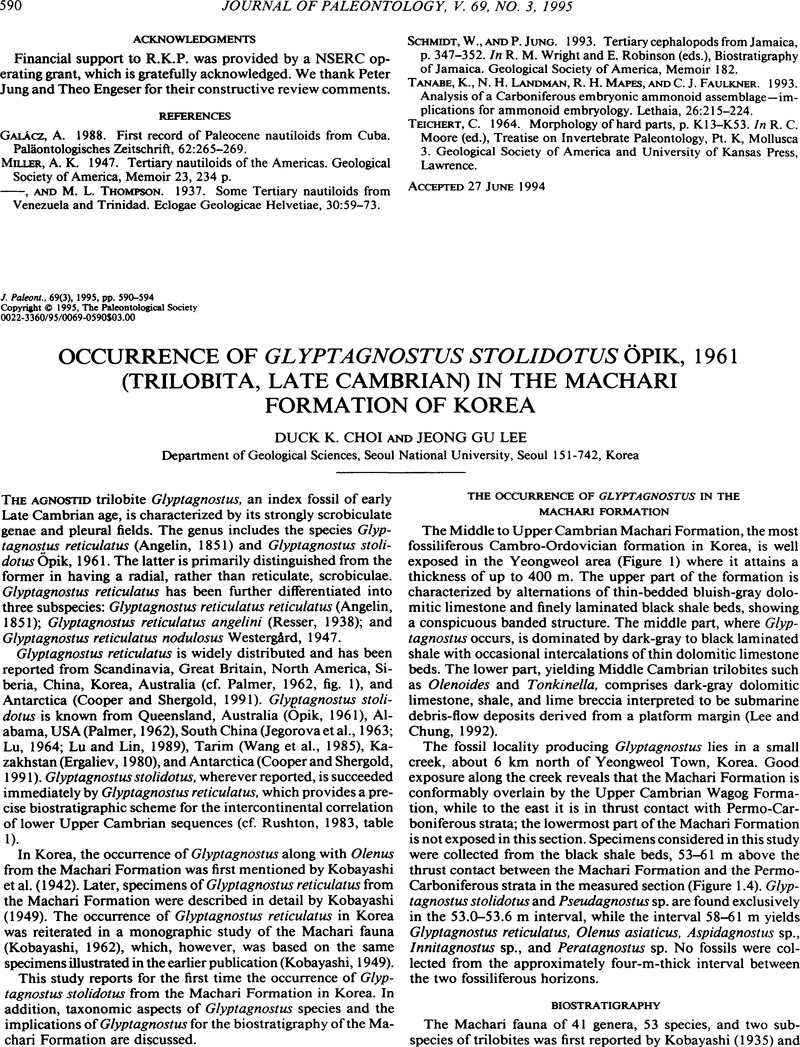Crossref Citations
This article has been cited by the following publications. This list is generated based on data provided by Crossref.
Choi, Duck K.
1998.
The Yongwol Group (Cambrian-Ordovician) redefined: a proposal for the stratigraphic nomenclature of the Choson Supergroup.
Geosciences Journal,
Vol. 2,
Issue. 4,
p.
220.
2000.
Marine Geology of Korean Seas.
p.
269.
HONG, PAUL S.
LEE, JEONG GU
and
CHOI, DUCK K.
2003.
TRILOBITES FROM THE LEJOPYGE ARMATA ZONE (UPPER MIDDLE CAMBRIAN) OF THE MACHARI FORMATION, YONGWOL GROUP, KOREA.
Journal of Paleontology,
Vol. 77,
Issue. 5,
p.
895.
Choi, D.K.
Kim, D.H.
Sohn, J.W.
and
Lee, S.-B.
2003.
Trilobite faunal successions across the Cambrian–Ordovician boundary intervals in Korea and their correlation with China and Australia.
Journal of Asian Earth Sciences,
Vol. 21,
Issue. 7,
p.
781.
HONG, PAUL S.
LEE, JEONG GU
and
CHOI, DUCK K.
2003.
TRILOBITES FROM THE LEJOPYGE ARMATA ZONE (UPPER MIDDLE CAMBRIAN) OF THE MACHARI FORMATION, YONGWOL GROUP, KOREA.
Journal of Paleontology,
Vol. 77,
Issue. 5,
p.
895.
Choi, Duck K
Lee, Jeong Gu
and
Sheen, Baek Cheor
2004.
Upper Cambrian agnostoid trilobites from the Machari Formation, Yongwol, Korea.
Geobios,
Vol. 37,
Issue. 2,
p.
159.
Hwang, Hyun-A
and
Choi, Duck K.
2005.
Heterochrony of the Late Cambrian olenid trilobites from the Machari Formation, Yeongwol, Korea: implications for biostratigraphy and intercontinental correlation.
Geosciences Journal,
Vol. 9,
Issue. 2,
p.
215.
Choi, Duck K.
and
Chough, Sung Kwun
2005.
The Cambrian-Ordovician stratigraphy of the Taebaeksan Basin, Korea: a review.
Geosciences Journal,
Vol. 9,
Issue. 2,
p.
187.
Choi, Duck K.
Kim, Eun-Young
and
Lee, Jeong Gu
2008.
Upper Cambrian polymerid trilobites from the Machari Formation, Yongwol, Korea.
Geobios,
Vol. 41,
Issue. 2,
p.
183.
Lee, Byung-Su
2013.
Middle Cambrian (Upper Series 3) protoconodonts and paraconodonts from the Machari Formation at Eodungol Section, Yeongwol, Korea.
Journal of Earth Science,
Vol. 24,
Issue. 2,
p.
157.
Hong, Paul S.
and
Choi, Duck K.
2015.
Cambrian series 3 agnostoid trilobitesPtychagnostus sinicusandPtychagnostus atavusfrom the Machari Formation, Yeongwol Group, Taebaeksan Basin, Korea.
Journal of Paleontology,
Vol. 89,
Issue. 3,
p.
377.
CHOI, Duck K.
LEE, Jeong Gu
LEE, Seung‐Bae
PARK, Tae‐Yoon S.
and
HONG, Paul S.
2016.
Trilobite Biostratigraphy of the lower Paleozoic (Cambrian–Ordovician) Joseon Supergroup, Taebaeksan Basin, Korea.
Acta Geologica Sinica - English Edition,
Vol. 90,
Issue. 6,
p.
1976.
Naimark, E. B.
and
Pegel, T. V.
2017.
Revision of the Cambrian Agnostina (Trilobita?) from Russia.
Paleontological Journal,
Vol. 51,
Issue. 11,
p.
1167.





